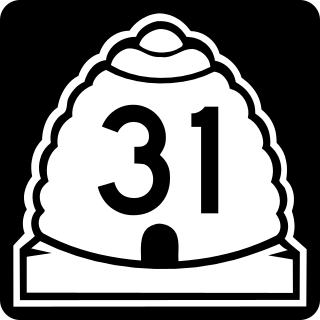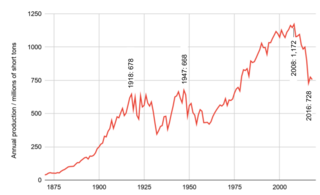
Massey Energy Company was a coal extractor in the United States with substantial operations in West Virginia, Kentucky and Virginia. By revenue, it was the fourth largest producer of coal in the United States and the largest coal producer in Central Appalachia. By coal production weight, it was the sixth largest producer of coal in the United States.

Donald Leon Blankenship is an American business executive and political candidate. He was chairman and CEO of the Massey Energy Company—the sixth-largest coal company in the United States—from 2000 until an explosion at one of his coal mines in 2010, costing him his position.
International Coal Group, Inc. (ICG), is a company headquartered in Teays Valley, West Virginia that was incorporated in May 2004 by WL Ross & Co for the sole purpose of acquiring certain assets of Horizon. ICG eventually operated 12 mining complexes in Northern and Central Appalachia and one complex in the Illinois Basin. In November 2005, ICG had a stock offering on the New York Stock Exchange. In 2011 ICG became a subsidiary of Arch Coal, Inc in 2011.

The Sago Mine disaster was a coal mine explosion on January 2, 2006, at the Sago Mine in Sago, West Virginia, United States, near the Upshur County seat of Buckhannon. The blast and collapse trapped 13 miners for nearly two days; only one survived. It was the worst mining disaster in the United States since the Jim Walter Resources Mine disaster in Alabama on September 23, 2001, and the worst disaster in West Virginia since the 1968 Farmington Mine disaster. It was exceeded four years later by the Upper Big Branch Mine disaster, also a coal mine explosion in West Virginia, which killed 29 miners in April 2010.

Peabody Energy is a coal mining and energy company headquartered in St. Louis, Missouri. Its primary business consists of the mining, sale, and distribution of coal, which is purchased for use in electricity generation and steelmaking. Peabody also markets, brokers, and trades coal through offices in China, Australia, the United Kingdom, and the United States.
The Aracoma Alma Mine accident occurred when a conveyor belt in the Aracoma Alma Mine No. 1 at Melville in Logan County, West Virginia, caught fire. The conveyor belt ignited on the morning of January 19, 2006, pouring smoke through the gaps in the wall and into the fresh air passageway that the miners were supposed to use for their escape, obscuring their vision and ultimately leading to the death of two of them. The two men, Ellery Hatfield, 47 and Don Bragg, 33, died of carbon monoxide poisoning when they became separated from 10 other members of their crew. The others held hands and edged through the air intake amid dense smoke.
The Crandall Canyon Mine, formerly Genwal Mine, was an underground bituminous coal mine in northwestern Emery County, Utah.
UtahAmerican Energy, Inc., is a Bituminous coal underground coal mine and lignite surface mining company, headquartered in Sandy, Utah. UtahAmerican is a subsidiary of Cleveland, Ohio based Murray Energy Corporation. UtahAmerican is a company with approximately $65.1 million (USD) in annual sales, and 428 employees and was started in 1996.

State Route 31 (SR-31) is a state highway in Sanpete and Emery Counties in the U.S. state of Utah. It runs for 47.746 miles (76.840 km) from US-89 at Fairview to SR-10 in Huntington. The highway has been designated as part of The Energy Loop, a National Scenic Byway.

Retreat mining is the removal of pillars in the underground mining technique known as room and pillar mining.

Robert Edward Murray was an American mining engineer and businessman. He founded and was the chief executive officer of Murray Energy, a mining corporation based in St. Clairsville, Ohio, until it filed for bankruptcy. Murray was criticized for his denial of climate change, his actions following the Crandall Canyon Mine collapse, and for several large SLAPP suits he initiated. Multiple allegations of sexual misconduct were brought against him in 2014 and 2016, which were later settled out of court.
A coal mine bump is a seismic jolt occurring within an underground mine due to the explosive collapse of one or more support pillars.

Richard E. Stickler served as acting Assistant Secretary of Labor for the Mine Safety and Health Administration (MSHA) between October 16, 2006 and October 21, 2009.
Mine Safety and Health News is the only credentialed, independent reporting service in the U.S. covering the Mine Safety and Health Administration and the Federal Mine Safety and Health Review Commission. It is not affiliated with any mining organization, lobbying group, policy group, labor or political organization, or mining company. It does not accept advertising and is strictly a subscription-based news and research publication.

Coal mining is an industry in transition in the United States. Production in 2019 was down 40% from the peak production of 1,171.8 million short tons in 2008. Employment of 43,000 coal miners is down from a peak of 883,000 in 1923. Generation of electricity is the largest user of coal, being used to produce 50% of electric power in 2005 and 27% in 2018. The U.S. is a net exporter of coal. U.S. coal exports, for which Europe is the largest customer, peaked in 2012. In 2015, the U.S. exported 7.0 percent of mined coal.

The National Mine Map Repository (NMMR) is part of the United States Department of the Interior (DOI), Office of Surface Mining Reclamation and Enforcement. The NMMR resides in the Pittsburgh suburb of Green Tree, Pennsylvania, and collects and maintains mine map information and images for the entire country, including data and maps of coal mines in the anthracite coal region of northeastern Pennsylvania. The Green Tree facility provides and stores, digitally and in microfilm, over 182,000 maps of abandoned mines. This repository contains maps of mine workings from the 1790s to the present day. It serves as a point of reference for mine maps and other information for both surface and underground mines throughout the United States. It also serves as a location to retrieve mine maps in an emergency. The NMMR provides services ranging from retrieving mine related data for economic analysis to assessing the potential risk associated with underground mining. Through analysis of mine maps and related information, the repository assists private and public sectors in industrial and commercial development, highway construction, and the preservation of public health, safety, and welfare. In addition, they collect, reproduce, and maintain a national inventory of mine maps and supporting documentation for private and public interests.

Joe Main is an American government official who formerly served as the Assistant Secretary of Labor for Mine Safety and Health and head of the United States Department of Labor's Mine Safety and Health Administration. He was nominated to serve the position by Barack Obama and took office after being confirmed by the United States Senate on October 21, 2009.

The Upper Big Branch Mine disaster occurred on April 5, 2010 roughly 1,000 feet (300 m) underground in Raleigh County, West Virginia at Massey Energy's Upper Big Branch coal mine located in Montcoal. Twenty-nine out of thirty-one miners at the site were killed. The coal dust explosion occurred at 3:27 pm. The accident was the worst in the United States since 1970, when 38 miners were killed at Finley Coal Company's No. 15 and 16 mines in Hyden, Kentucky. A state funded independent investigation later found Massey Energy directly responsible for the blast.
Alpha Natural Resources is a large American producer of metallurgical coal for the industrial production of steel and iron and low-sulfur thermal coal to fuel steam boilers for the production of electrical power. In November, 2018 the company was acquired by Contura Energy. The company also provides industry services relating to equipment repairs, road construction and logistics, with domestic operations and coal reserves within the states of Virginia, West Virginia, Kentucky, Wyoming, Utah, Illinois, Tennessee, and Pennsylvania. Alpha Natural Resources does not produce all of the coal it sells; much of the coal sold by Alpha Natural Resources is purchased from independent mining operations and then resold in the worldwide market.

"SLAPP Suits" is a segment of HBO's news-satire television series Last Week Tonight with John Oliver, focusing on strategic lawsuits against public participation (SLAPP). It first aired on November 10, 2019, as part of the twenty-ninth episode of the series's sixth season. The episode marked British-American comedian and host John Oliver's response to winning a SLAPP defamation lawsuit against him initiated by American mining businessman Robert E. Murray. The lawsuit began in 2017, after Oliver heavily criticized Murray and his company, Murray Energy, in a segment concerning the coal-mining industry in the United States. Murray claimed in his lawsuit that Oliver had carried out a character assassination against him, but the case was dismissed in under a year, and an appeal by Murray Energy was unsuccessful. During the lawsuit, the American Civil Liberties Union filed an amicus brief that was widely covered due to its sarcastic humor.













